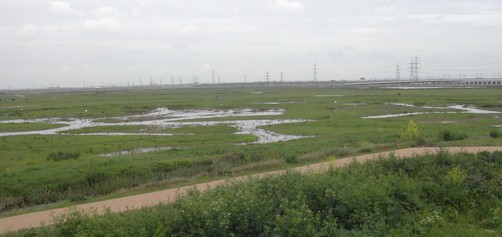Rainham Marshes
From Londonbirders
| (21 intermediate revisions not shown) | |||
| Line 39: | Line 39: | ||
---- | ---- | ||
| - | Patchlist | + | Dave Morrison Patchlist 2008: |
| - | Species List - | + | Greylag Goose, Corn Bunting, Barnacle Goose, Cetti's Warbler, Lapwing, Black Headed Gull, Lesser Black Backed Gull, Herring Gull, Common Gull, Great Black Backed Gull, Meadow Pipit, Rock Pipit, Great Tit, Blue Tit, Cormorant, Grey Plover, Shoveler, Teal, Magpie, Redshank, |
| + | Water Pipit, Curlew, Shelduck, Starling, Mallard, Grey Heron, Carrion Crow, Wren, Robin, Blackbird, Fieldfare, Jackdaw, Moorhen, Kestrel, Chaffinch, Linnet, Kingfisher, Coot, Pied Wagtail, Gadwall, Stonechat, Woodpigeon, Tufted Duck, Pintail, Common Snipe, Canada Goose, Dunnock, Sparrowhawk, Grey Wagtail, Little Egret, Mute Swan, Reed Bunting, Siskin, Pheasant, Stock Dove, Feral Pigeon, Collared Dove, Mistle Thrush, Greenfinch, Bearded Tit, Skylark, Short Eared Owl, Ring Necked Parakeet, Slavonian Grebe, Peregrine Falcon, Golden Plover, Little Grebe, Black Tailed Godwit, Goldeneye, Great Crested Grebe, Kittiwake | ||
| + | |||
| + | Species List - 72 | ||
Current revision as of 19:47, 3 January 2008
Rainham Marshes covers a vast area alongside the River Thames in East London. It is divided into several distinct areas: the RSPB Reserve, the Ferry Lane end, and the Tip (an active refuse dump for which there is no public access).
Directions:
RSPB Reserve:
By car: From the A13 eastbound, take the A1306 turn-off (Signposted Wennington, Aveley and Purfleet.) At the slip road roundabout turn right, following signs for Purfleet on the A1306 heading east. Continue along the A1306 for ½ mile. At the traffic lights, take a right hand turn, signposted A1090 to Purfleet onto New Tank Hill Road flyover. The entrance to the reserve approximately 300 metres along this road, just after the bottom of the flyover on the right hand side. Car park fee for non-members.
By train: Nearest railway station is Purfleet (trains from Fenchurch Street or Barking. On leaving Purfleet Station, turn right, follow the road until the pub, 'The Royal', on the left hand side. At The Royal, head down to the Thames and join the Riverside Path. Follow the path, which eventually crosses the Mardyke River at a small bridge. After the bridge, turn left and follow the pavement around to the RSPB Centre.
Ferry Lane End:
By car: From the A13, take the Ferry Lane exit (near Rainham town) and follow the road towards the river. Take the first turning on the left, Coldharbour Lane, which runs alongside the old marshes. After 500 metres, on the right hand side just before the raised silt lagoons, is a turning to the coastal car park. This area is also known as the Stone Barges.
By train: Nearest railway station is Rainham, Essex (trains from Fenchurch Street or Barking. On leaving Rainham Station, turn right, cross over the level crossing and follow the road round with the marshes on your left.
Access: The RSPB Reserve is open daily from 09.30 – 16.30. There are trails and a boardwalk. There is a public footpath along the river wall which overlooks the RSPB Reserve. The Ferry Lane end is open access but check signs for car park opening hours. A public footpath runs along the river wall. The refuse tip is strictly off-limits.
Birds
Rainham Marshes is the premier birding site in London and over 150 species occur annually. Its proximity to the Thames means that it is in a prime position to attract migrants, including rarities. However, it is because it is one of the last remaining areas of marshes in London that provides a habitat for birds which are difficult to see elsewhere that makes it a special place.
All Year: Little Egret, Peregrine, waders, Stonechat (along Ferry Lane and on the reserve).
Winter: Rock and Water Pipits (they favour the Stone Barges); waders, especially flocks of Black-tailed Godwits (they roost on the reserve at high tide); Hen Harrier and Merlin (scarce, best scanned for from the river wall). Short-eared Owl (best from Ferry Lane).
Summer: Reed and Sedge Warblers (all over).
Spring/Autumn: waders (best along the Thames and on the reserve).
Rarities: Up to four Penduline Tits have been seen in the last three winters (on the reserve); Sociable Lapwing and Collared Pratincole (on the reserve in 2005). There have also been records of Rough-legged Buzzard, Lesser Kestrel, two Red-footed Falcons, Common Crane, Western Sandpiper, Baird’s Sandpiper, Buff-breasted Sandpiper, Solitary Sandpiper, Ring-billed Gull, Red-throated Pipit, Bluethroat and Aquatic Warbler.
Dave Morrison Patchlist 2008:
Greylag Goose, Corn Bunting, Barnacle Goose, Cetti's Warbler, Lapwing, Black Headed Gull, Lesser Black Backed Gull, Herring Gull, Common Gull, Great Black Backed Gull, Meadow Pipit, Rock Pipit, Great Tit, Blue Tit, Cormorant, Grey Plover, Shoveler, Teal, Magpie, Redshank, Water Pipit, Curlew, Shelduck, Starling, Mallard, Grey Heron, Carrion Crow, Wren, Robin, Blackbird, Fieldfare, Jackdaw, Moorhen, Kestrel, Chaffinch, Linnet, Kingfisher, Coot, Pied Wagtail, Gadwall, Stonechat, Woodpigeon, Tufted Duck, Pintail, Common Snipe, Canada Goose, Dunnock, Sparrowhawk, Grey Wagtail, Little Egret, Mute Swan, Reed Bunting, Siskin, Pheasant, Stock Dove, Feral Pigeon, Collared Dove, Mistle Thrush, Greenfinch, Bearded Tit, Skylark, Short Eared Owl, Ring Necked Parakeet, Slavonian Grebe, Peregrine Falcon, Golden Plover, Little Grebe, Black Tailed Godwit, Goldeneye, Great Crested Grebe, Kittiwake
Species List - 72

